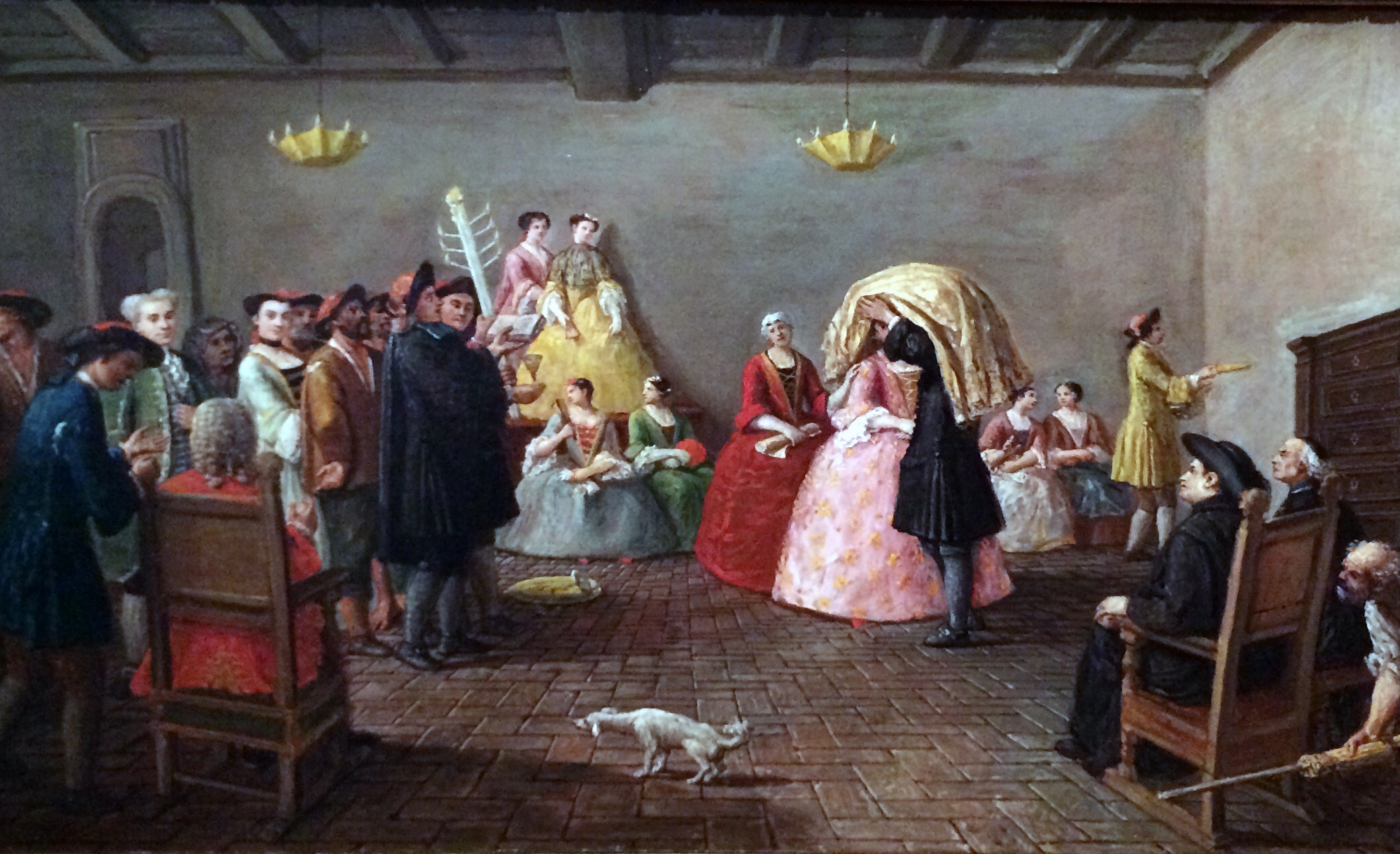Got a question for Philologos? Ask him directly at [email protected].
A while ago, a copy of an article from a newly published book called Jewish Languages in Historical Perspective turned up in my email. Its author was the Italian linguist Maria Maddalena Colasuonno, and its title was an academic-sounding mouthful: “Modern Judeo-Italian in the Light of Italian Dialectology and Jewish Interlinguistics through Three Case Studies: Judeo Mantuan, Judeo-Venetian, and Judeo-Livornese.” I glanced at it and put it away.
This week, I picked up Colasuonno’s article again and read it through. There, amid her technical discussions of such differences between Judeo-Italian and ordinary Italian dialects as “[The] Anaptyctic Vowel,” “Fricativization of the Occlusive p,” “Absence of the Clitic Pronoun as Subject,” and “Circumfix (i.e., Bipartite) Negation,” was a little Judeo-Mantuan poem so charming that I can’t resist sharing with you.
A few words of background are called for. Mantua, Italian Mantova, is a town in southern Lombardy, about 100 kilometers southwest of Venice and a similar distance southeast of Milan—which puts it, as Colasuonno points out, well above the line, or isogloss, separating northern Italian dialects like Piedmontese and Lombard from central ones like Tuscan and Roman. The town’s Jewish population, though never large, was a thriving one until it began to depart for larger urban centers in the late 19th century, leaving barely 500 Jews in Mantua at the outbreak of World War II.
Thus, while Mantovan dialect, a variety of Lombard, is still spoken and understood by many Italians in the area, its Jewish form vanished in the first half of the 20th century. No speakers of it exist anymore, and our knowledge of it depends entirely on written sources. Foremost among these are the writings of a Mantuan Jewish physician named Annibale Gallico, who was born in 1876, died in 1935, and wrote a large number of humorous poems about Mantua’s Jewish community.
Gallico’s verse was collected and published in 2014 in a volume called Storie Vecie, “Old Stories,” from which the poem cited by Colasuonno was taken. The latter’s title of Un Gomèl, “A Gomèl,” refers to the ha-Gomel (literally, “[Blessed be] He who requites”) prayer, traditionally recited in synagogue by a Jew who has survived serious danger. Here are the poem’s twelve lines, the last ten of which are put in the mouth of a storyteller named Scarponsel or “Little Boot”:
Non ghe meti sal nè péver,
la contava Scarponsel:
Una volta Prosper Rever
è andá a scόla a far gomèl.
El moreno ghe demanda
che maccá gh’era succès.
Lu s’el tira de una banda
e ghe dis col cόr sospés:
“M’è cascá dal davansal
la camisa de percal:
E se denter ghe fuss stá?”
“Ma che vaga in chelalá!”
And here, with Colasuonno’s assistance, is my free translation, which attempts to preserve the poem’s rhyme and rhythm:
I’ll add neither salt nor pepper
to what I heard from Scarponsel:
One time Prosper Rever
went to shul to make gomèl.
And when the rabbi asked him
what misfortune he had fled,
he took him to one side and with
a beating heart he said:
“My gingham shirt fell to the ground
from the windowsill.
What if I’d been in it?”
Said the rabbi, “You’d be dead!”
Colasuonno’s literal version of these lines goes:
I won’t add here either salt or pepper [i.e., the poet is not going to embellish but rather is going to tell the story exactly as Scarponsel told it to him]./ Scarponsel recounted:/ Once upon a time Prosper Rever/ went to the synagogue to do a gomèl./ The rabbi asked what disgrace had happened to him./ He took him aside/ and said with bated heart,/ “My gingham shirt/ fell from the windowsill./ And if I had had it on?”/ [The rabbi said] “You may have gone to rack and ruin!”
Although they hail from Mantua, Prosper Rever and his rabbi would feel perfectly at home in Chelm!
Readers who know Italian will have noticed in Gallico’s poem some characteristic ways in which Judeo-Mantuan differs from standard Italian. Standard gli and ci, for example, become ghe. Judeo-Mantuan tends to drop the final Italian “e,” as in far instead of fare (to make) or davansal, windowsill, for davanzale. It also shortens past tenses, as in è andá, “[he] went,” rather than è andato, and cascá, fell, for cascato.
None of these, however, is a specifically Judeo-Mantuan form. They are Lombard ones, and in this respect Judeo-Mantuan does not depart from general Lombard usage. What is unique to it, as to all distinctly Jewish speech, is its frequent resort to Hebrew. Apart from gomèl, there are three other Hebrew words in Gallico’s poem. The first is maccá, misfortune, from makkah, “blow.” The second is morenu, literally, “our teacher,” used in Judeo-Mantuan to mean “rabbi.” The third is chelalá, Colasuonno’s “rack and ruin,” from Hebrew k’lalah, “curse.”
In addition, there is yet another word in the poem, scόla, synagogue, that was used by Jews only. This is the same word that gives us Yiddish shul. Both derive from Latin schola, school, and owe their Jewish meaning to the Hebrew term bet-midrash, study house, which is a near-synonym in rabbinic literature for a bet-k’neset or synagogue—the reason being that Jewish study and Jewish prayer were generally conducted in the same place.
But since—apart from its Hebrew, a handful of Judaized non-Hebrew words like scόla, and some very minor phonetic and grammatical divergences—Judeo-Mantuan is identical to Mantuan Lombard, does it make sense to speak at all of a “Judeo-Mantuan” (or for that matter, “Judeo-Italian”) dialect?
Let’s think for a minute of the English spoken by many Orthodox Jews in America. It would be perfectly normal for one of them to say, “I went to shul to bentsh gomel and when I told the rov that my shirt fell from the window and I could have been in it, he said khas v’sholem!” Does this mean that there is such a thing as a Jewish dialect in America?
To an extent, the question is a semantic one, a matter of what we choose or don’t choose to call a dialect. Some of the English spoken by Jews in America is indeed like Judeo-Italian: it routinely inserts Jewish words with religious referents that non-Jews don’t understand into sentences that are, grammatically and syntactically, no different from other English sentences. But this also makes both such English and Judeo-Italian different from a language like Yiddish, which, though Germanic in origin, has not only a huge non-Germanic vocabulary for everyday items and concepts unrelated to religion but also a grammar and rules of syntax that differ from German’s considerably.
Historically, the formation of true Jewish languages like Yiddish, as opposed to Jewish forms of speech like Judeo-Italian or Orthodox Jewish English, has depended on a high degree of separation between Jewish and Gentile society that has enabled Jews to develop linguistically in isolation. Such conditions existed in Eastern Europe. They did not exist in Italy despite ghettos like those of Rome and Venice, just as they do not exist in the United States despite its large Orthodox and ultra-Orthodox communities. An Italian “Yiddish” was never in the cards. Neither is an American “Yiddish” today.
Got a question for Philologos? Ask him directly at [email protected].
More about: Arts & Culture, History & Ideas, Italian Jewry, Jewish language







